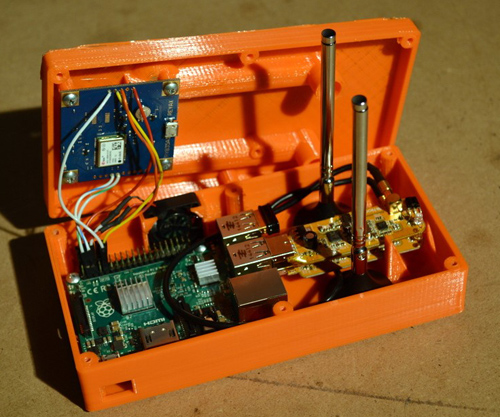DIY In-Cockpit Weather, Traffic, and More! An Update on the “Stratux” Project
By Tom Charpentier, Government Advocacy Specialist, EAA 1082006
The biggest change since our first report is the addition of new peripheral devices. The software now has stable support for two digital radio tuners, meaning that a device so equipped will now be dual band, receiving 978 UAT (weather and traffic) and 1090ES (more traffic). The band you will receive traffic on depends on the band the traffic broadcasts on. Since 1090ES is required above 18,000 feet, it is used by commercial traffic and many GA aircraft, so adding 1090ES functionality greatly expands the traffic picture that you will see in many areas.
The second optional peripheral is the RY835AI chip, which includes a GPS, gyroscope, and pressure sensor. Support for the latter two items is still being worked on, but we found the GPS to be accurate and useful for devices such as tablets without an internal GPS chipset. Adding the RY835AI combines all functions needed for aviation into a single unit, decluttering your glareshield. If you are just interested in GPS, support has recently been added for the VK-172, a USB WAAS GPS, which retails for just $20.

The RY835AI has a USB cable, but users have found that hardwiring it to the Raspberry Pi’s input/output pin bus is a more reliable connection
Chris and project contributors also added a handy web-based interface to the unit, broadcasting a webpage over the Raspberry Pi’s WiFi that includes diagnostic information and configuration menus.

The user interface contains both diagnostic information and configuration options
There are a few tricks to building the expanded setup. While the original single-band unit simply required the builder to plug a few things in, the extra gadgets really demand a custom case to keep everything organized. Fortunately there is a growing list of 3D-printed cases that are designed specifically for this project. I built this one, designed by Tony Kirk (EAA 380657), which includes an optional fan to help with cooling and integral folding antennas.

You may notice some imperfections in the print – we were using an off-brand filament and I plan to re-print
Note the RY835AI wired to the pin bus; there are also 5V and ground pins available for the fan
A colleague built this one (designed by Scott VanderVeen of Pro-Composites and EAA SportAir Workshops), which has aftermarket antennas but a little more compact form factor.

We are working on an internal antenna solution, but you can also run “pigtails” from the radio tuners to the ports on the case for exterior antennas
Most cases require you to remove the plastic housing on the radio tuners. Make sure to insulate all contact points that might be in danger of shorting across other metal parts. Some cases have the tuners plugged directly into the Pi, others use short USB extensions for remote mounting.
Don’t have a 3D printer? No worries! Online services such as makexyz will print any file you send them for a reasonable price, and rental/communal printers are found in more and more communities, even at some public libraries! We did find that the PLA material used by many entry-level printers has a lower melting point than most consumer plastics, so avoid exposing your case to excessive heat. Alternatively you can use a more heat-resistant material such as ABS, nylon, or forget the 3D printer entirely and build your own case out of anything you want. This is what EAA is all about – experiment and be creative!
One consideration when using all peripherals is power consumption. A light-duty 12V phone charger or a small portable battery can run the unit in the basic setup, but for the fully-equipped unit you should invest in a high-amperage power source and a quality cable. 2 amps seems to be a good minimum to ensure adequate power.
As always, your eyes should be your primary traffic-avoidance tool. But the expanded traffic functionality can help situational awareness in busy areas, and for an extra $25 for the extra tuner it’s a worthwhile investment. It remains to be seen if the full potential of the GPS/AHRS chip can be unlocked, but for those pilots requiring a peripheral GPS for their tablets, the addition of the chip is already worth it.
|
A Further Update
Development in the electronics business rarely stagnates. Recently, an even smaller version of the radio tuner, the NESDR Nano 2, has been added to Amazon ($25). This allows for a more compact installation, with a form factor approaching that of many commercially-available products.
Speaking of commercially-available, one of the contributors to the project recently began a Kickstarter campaign to fund the production of an all-inclusive kit. The “FlightBox” project will include a Raspberry Pi, two radio tuners for dual band functionality with custom antennae, and WAAS GPS, all inside a custom case.
Chris and the rest of the developers continue to explore what the Raspberry Pi platform can bring to general aviation. The project is beginning to expand beyond ADS-B into other flight information, including attitude, pressure altitude, and could one day even incorporate airspeed and angle of attack! We’ll continue to provide updates as the project progresses. |



